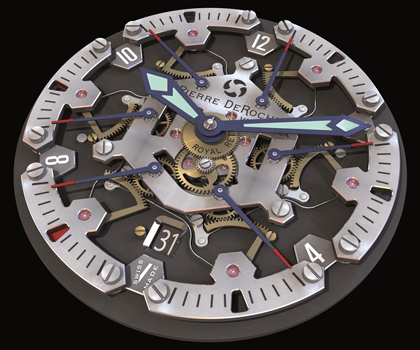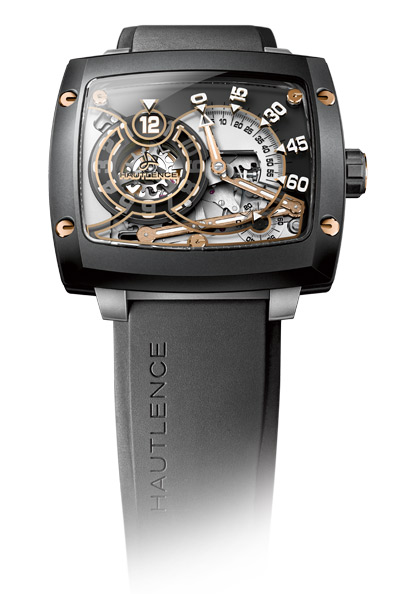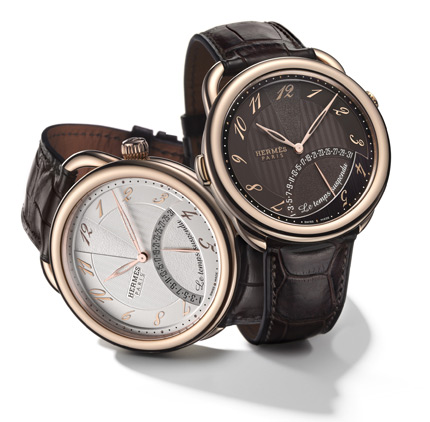A few years ago, I had a very interesting chat with genius watchmaker Jean-Marc Wiederrecht, who was convinced that we are living in one of the most exciting eras of watchmaking history. This is an interesting viewpoint to take, considering that today's innovation can almost be considered reinventing the wheel rather than making technical advances.
I also believe that Wiederrecht is correct. The technical advances of the past – and even the distant past – have led to more accurate mechanical timepieces; the technical research of today is leading timepieces to become more beautiful, aesthetic, and interesting. Which is exactly what a luxury product should be.

A view of Pierre de Roche's six-retrograde movement © Pierre de Roche
Wiederrecht, of course, held the original patent for the retrograde display as we know it together with Roger Dubuis, registered in 1988. I once asked Wiederrecht why we were seeing so many retrograde developments in horology in recent years and received a surprising answer: the patent has expired and others are now able to legally use the technology – if they have not already developed their own system. “Many people love it and now everybody uses it. And now I am making other things,” he said to me at the time with a grin.

In one form or another, “retrograde” has been in existence for 200 years, starting with the bras en l'air watches of the eighteenth century, a time when watchmakers were occupied with developing the first retrograde displays as an alternative to the “regular” round indication. Retrograde displays may be enjoying a revival in the current era, thanks to the constant and fascinating motion on the dial, but the montre en bras (literally: “watch in arms”) often contained another clever specialty that today's retrogrades do not usually deliver with the exception of Thomas Prescher's Tempusvivendi and Van Cleef & Arpels' Lady Arpels Ballerine. The human or animal figures of these timepieces are at rest, in a “non-temporal” state, when not indicating the time. When a button on the crown is pressed, the exquisitely engraved figure's arms automatically jump to show the correct current time on the retrograde arcs. As soon as the button is let go, the arms relax again to return to their original state. The wearer can also often choose to have the figures continuously show the time.

The Lady Arpels Ballerine with its double retrograde and “rest” mode is a modern montre en bras © Van Cleef & Arpels
Abraham-Louis Breguet used a form of retrograde to make the mechanical thermometer in his timepieces, and even the réserve de marche (power reserve indication) is a very small form of retrograde.
Wiederrecht is behind some of our era's most imaginative retrograde watches: various Van Cleef & Arpels models, Hermès' Temps Suspendu, a very small limited edition for DeLaneau, and the Harry Winston Opus 9, which Wiederrecht describes as a form of retrograde as well.

Though Wiederrecht was not involved, the original Hautlence concept was (and remains) rooted in retrograde: the hour disk, located on the left side of the dial, displays the current hour by means of jumping action that is propelled by the connecting rod (visible horizontally along the bottom of the dial) between the hour disk and the retrograde minutes. When the minute hand reaches the end of its arc, its movement sets the connecting rod into motion and propels the disk forward one space.
Pierre de Roche also profits from the fascination of retrograde technology with the TNT Retro models, where six indications each serially display 10 seconds, seeming to pass an imaginary baton from one little hand to the next. As the graphic shows, the technology of the Pierre de Roche retrograde utilizes a rack, a gear wheel, and a lever (the usual method includes a spring). The spectacle of six little hands go, go, going is pure fascination – and proof positive as to why the retrograde is always such a popular choice for an appealing, out-of-the-ordinary display.








